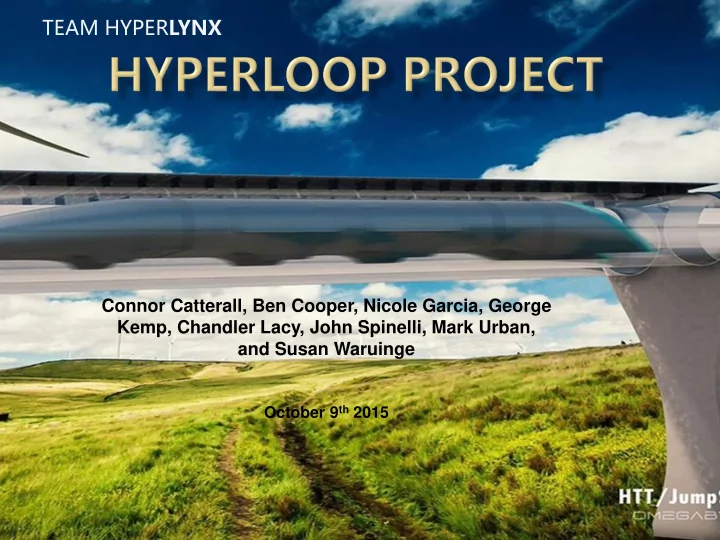

TEAM HYPER LYNX Connor Catterall, Ben Cooper, Nicole Garcia, George Kemp, Chandler Lacy, John Spinelli, Mark Urban, and Susan Waruinge October 9 th 2015
Pod Components Discussion Summary/Conclusions Mass Flow Recommendations Compressor Controls Air Bearings Linear Induction Motor Brakes Frame
What is a Hyperloop? Proposed by Elon Musk, the founder of Tesla and SpaceX New form of transportation that will consist of a pod traveling in a low pressured tube on a frictionless surface at speeds near Mach 1. Purpose The mission of team Hyperlynx is to design and manufacture a Hyperloop pod demonstrating the safety, stability and feasibility of the Hyperloop system.
Building a half size pod 14 feet long 4 feet wide The pod will be compete in a proof of concept competition at SpaceX headquarters in June 2016 Over 200 teams 1 mile long straight test track 5 feet diameter tube
𝑁 = 𝑊 𝐷 𝑊 = Relative Speed C = Speed of Sound Mach Regimes M Classification Low Subsonic 𝑁 High Subsonic 𝑁 8 Transonic 𝑁 Sonic 𝑁 = Supersonic 𝑁 𝑁 = unity Hypersonic 𝑁 Hyper Velocity 𝑁 25
Mass Flow in the Hyperloop 𝑆𝑓 = 𝜍𝑊𝐸 𝐼 𝑆𝑓 laminar ; 𝑆𝑓 > 4 turbulent 𝜈 Five Control Volumes 1. Overpass 2. Inlet 3. Diffuser 4. Underpass 5. Outlet
Axial compressor Primary function is to decrease mass flow rate around the pod to avoid choked flow • Also provides compressed air to the air bearings Advantages • Efficiencies up to 90% • Capable of high mass flow rates • Lightweight
Mass Flow Rate into Compressor 0.35 Mass flow rate into compressor to avoid choked flow 0.3 Actual flow rate into Mass flow rate (kg/s) 0.25 compressor 0.2 0.15 0.1 0.05 0 0 50 100 150 200 250 300 350 400 Velocity (m/s)
Compressor Shaft Power Requirement 50 45 40 35 30 Power (kW) 25 20 15 10 5 0 0 50 100 150 200 250 300 350 400 Velocity (m/s)
Intercooler draws heat from air exiting the compressor Independent pressure vessels provide flow to bearing and cabin
Off-board CPU will monitor internal functions On-board CPU will perform autonomously Advantages of Arduino Low power • consumption • Number of I/O ports Ease of coding •
Provide levitation and almost frictionless travel 16 air bearings, located on either side of the pod Total specs Load capacity - 12,800 lb Air consumption - 160 scfh Pressure - 60 psi Limitations How to overcome shear stress Images courtesy of nelsonair.com Requires perfectly machined tube
Suggested to SpaceX by MIT Rail fixture attached to the top of tube Will solve additional issues related to stability and braking Limitations Force of rolled steel bar will be very high, especially around turns. If SpaceX uses the rail idea, Image courtesy of MIT Team calculations must be initiated to determine strength of rail and max speeds.
Propulsion System Used to accelerate and decelerate the pod Primary (stationary) component: Stator (provided by SpaceX) Constructed into the tube Secondary (moving) component: rotor Constructed to the Pod Main braking system Will recapture energy from moving pod while decelerating pod
Deceleration values Braking Force Human comfort: 0.15g 25000 30 Untrained human Force (lb) 20 g for less than 10 s Distance to Stop (mi) 25 10 g for 1 min 20000 6 g for 10 min Distance to Stop (mi) Main braking system 20 15000 Force (lbf) Linear induction motor Emergency braking system 15 Landing gears and disc barkes 10000 10 Turn off compressor Barricade 5000 5 0 0 0.15 1 2 3 4 5 6 10 20 Deceleration (g) Note: Calculation based on 1000 lb mass
Material Aluminum 2024 Reinforced with ribs and stringers Advantages: Increase buckling strength Stability Structural Integrity Frame shelled with aluminum, riveted to body.
Front View Side View
Our design is optimized to prevent choke flow by pulling air through the pod instead of around Pressurized air onboard system for air bearings that will provide a frictionless surface The frame is designed to minimize weight and drag while maximizing strength The LIM will provide sufficient propulsion to keep the pod moving at above 700mph.
Validating computer modeling with experimental data Wind tunnel test Air Bearing Test Create a working model 1/10 th scale. Work with electrical engineers for the control system Test LIM and create process sheets for rotor.
Doug Gallagher Ron Rorrer Joseph Cullen Denver Channel 7 CBS All our Kickstarter Backers College of Architecture
http://www.wired.co.uk/news/archive/2015-05/28/elon- musk-hyperloop-might-be-free-breaking-ground-in-2016 https://en.wikipedia.org/wiki/G-force NMAN news direct Matlab Simulink Hyperloop App David Dearing (compressor design) Mario Paredes (seats design)
Recommend
More recommend